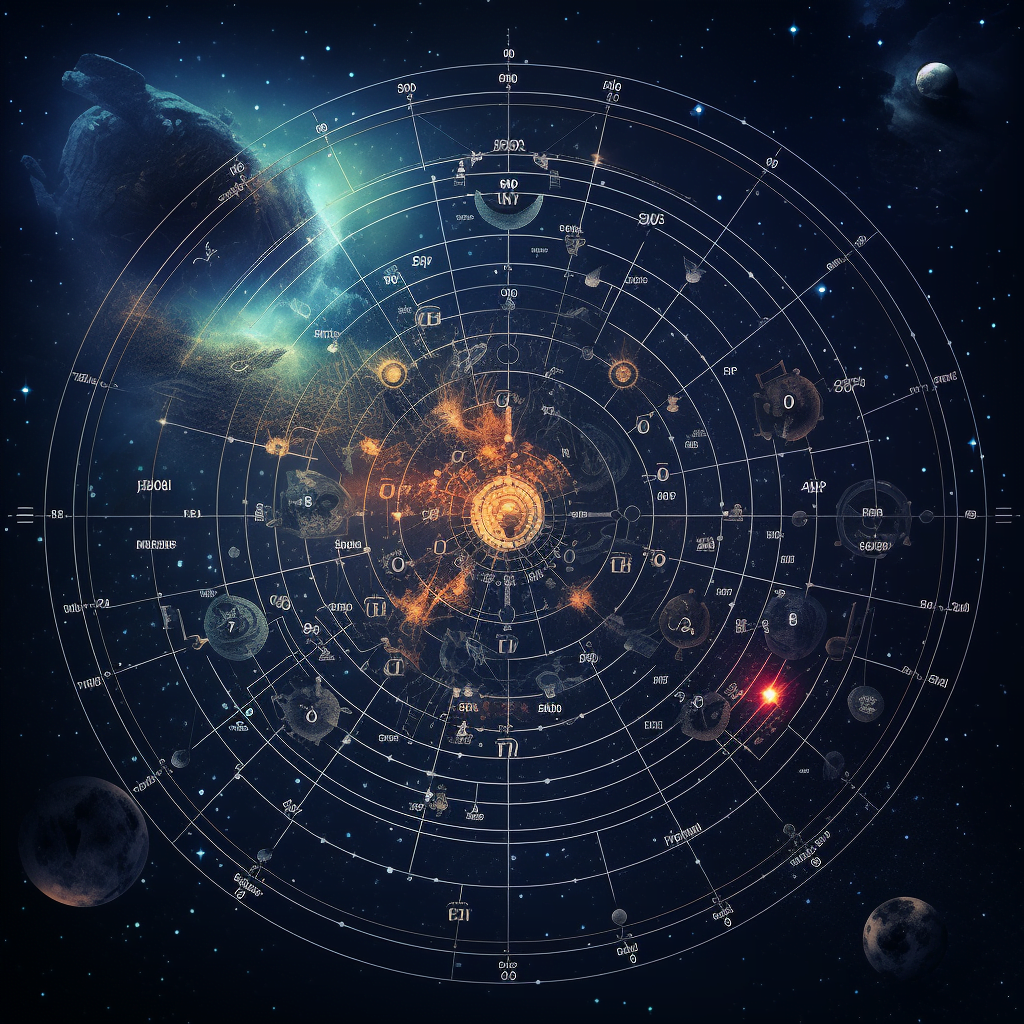Star charts, also known as natal charts or astrology birth charts, are intricate maps of the heavens customized to reflect the exact time and location of a person’s birth. By mapping the positions of the sun, moon, planets, and astrological houses at this moment in time, star charts aim to provide insight into a person’s character, motivations, challenges, and life path. So lets answer the good old question What is a Star Chart Astrology?
Overview of Star Charts
A star chart is calculated based on the 12 signs of the zodiac and the placement of celestial bodies from the perspective of Earth at a specific date, time, and location. The chart forms a snapshot of the heavens at the moment of a person’s first breath.
Star charts have been used for thousands of years to gain self-knowledge and direction. By considering the unique arrangement of the cosmos at birth, astrologers aim to uncover hidden truths about a person’s psyche, talents, relationships, and destiny.
While often referred to as natal or birth charts, the technical term for a personalized astrological map is a horoscope. The word “horoscope” comes from the Greek words “hora” meaning “time” and “skopos” meaning “observer.”
History and Origins of Star Charts
The practice of astrology and the use of star charts dates back thousands of years to ancient Mesopotamia, Egypt, India, China, and Central America. Some of the earliest astrological writings and diagrams come from the 2nd millennium BCE in Mesopotamia.
In ancient times, astrology was often intertwined with astronomy and considered an esoteric science. Astrologers acted as priest-like advisors who helped monarchs and leaders make important decisions at critical junctures by referencing the heavens.
Major developments in astrology and natal chart calculation unfolded in ancient Egypt, where the 12 signs of the zodiac first came into common usage between the 2nd and 4th centuries BCE. The Egyptians also pioneered horoscopic astrology, or the preparation of star charts tied to specific individuals based on date and location of birth.
By the 1st century BCE, natal star charts were widespread across the Mediterranean and Middle East. Astrology was a respected science integrated with medicine, meteorology, and other studies of the natural world. Its influence continued in Islamic cultures during the Middle Ages even as it fell out of favor in Europe temporarily.
Today astrology remains an important spiritual practice in many parts of Asia as well as experiencing renewed interest in the West in recent decades. New psychological approaches also connect astrology to the works of Jung, archetypes, and the subconscious mind.
Key Parts of a Star Chart
While star charts may appear complex to the naked eye, they contain just a few key components that work together to convey meaning.
The 12 Signs of the Zodiac
The 12 zodiac signs – Aries, Taurus, Gemini, Cancer, Leo, Virgo, Libra, Scorpio, Sagittarius, Capricorn, Aquarius, and Pisces – play a pivotal role. Each occupies a 30 portion of the heavens through which the sun, moon, and planets travel.
In a star chart, the zodiac signs provide critical information about core personality traits a person may exhibit. For example, Leo correlates to creativity, drama, and leadership while Virgo represents analytical skills and perfectionism.
Each zodiac sign corresponds to one of the four elements fire, earth, air, and water and takes on characteristics of that element. The fire signs are Aries, Leo, and Sagittarius; the earth signs are Taurus, Virgo, and Capricorn; the air signs are Gemini, Libra, and Aquarius; and the water signs are Cancer, Scorpio, and Pisces.
In addition to element categorization, the zodiac signs occur in polarity pairs Aries/Libra, Taurus/Scorpio, Gemini/Sagittarius, Cancer/Capricorn, Leo/Aquarius, Virgo/Pisces. Signs in the same polarity have an intrinsic energetic relationship.
The signs also form symbolic representations through figures from mythology. For example, Aries relates to the ram, Taurus the bull, and Leo the lion. These archetypes further shape the astrological interpretations of the signs.
Planet Positions
The planets in our solar system Sun, Moon, Mercury, Venus, Mars, Jupiter, Saturn, Uranus, Neptune, and Pluto each emit a unique energetic frequency. Their positions in the zodiac signs and houses influence character.
For a star chart, astrologers analyze the placement of 10 major celestial bodies:
The Sun – Indicates conscious purpose, will, self-expression, and the present. Connected to the father.
The Moon – Governs emotions, intuition, nurturing ability, and the past. Linked to the mother.
Mercury – Rules intellect, communication style, learning, exchange. Tied to siblings, schooling.
Venus – Represents love, beauty, money, possessions, social behavior. Associated with art, partners.
Mars – Energizes ambition, drive, courage, aggression, passion. Connected to contests, fights.
Jupiter – Expands learning, luck, travel, philosophy, openness. Often symbolizes husbands.
Saturn – Restricts through boundaries, hard lessons, focus, loyalty, parenthood. The great teacher.
Uranus – Radicalizes life through change, originality, technology, innovation, independence.
Neptune – Spiritualizes existence through dreams, visions, illusions, psychic ability, imagination.
Pluto – Transforms what it touches through intensity, secrets, rebirth, taboos.
Planets in signs compatible with their natures (such as Moon in Cancer) operate smoothly. But placements in discordant signs (like Saturn in carefree Sagittarius) pose challenges to overcome.
The 12 Astrological Houses
There are 12 astrological houses that represent different life spheres like identity, relationships, career, finances, travel, and spirituality. Planetary placements within them shape these areas.
Each house correlates to everyday experiences. Starting from the Ascendant or rising sign, the houses and their domains are:
1st House – Personality, physical appearance, self
2nd House – Money, possessions, financial security
3rd House – Communication, thought processes, siblings, schooling
4th House – Home, family, roots, heritage, foundations
5th House – Romance, fun, creativity, children, leisure
6th House – Health, daily routine, service, work environment
7th House – Partnerships, marriage, contracts, agreements
8th House – Sex, death, debts, taxes, shared resources
9th House – Higher learning, expansion, travel, philosophy
10th House – Career, public image, status, responsibility
11th House – Groups, friends, hopes, community, humanity
12th House – Spirituality, dreams, institutions, self-undoing
Tracking planets through these houses reveals which life spheres they impact most. Planetary energies come out strongly in the houses they occupy or rule.
Aspects and Angles
Aspects are geometric angles formed between planets that indicate their relationship and interactions. Key aspects are trines, squares, oppositions, sextiles, and conjunctions. Angles like the Ascendant and Midheaven also hold meaning.
Conjunctions occur when planets align tightly together, intensifying joint energies.
Sextiles form 60 angles that facilitate the planets working in harmony.
Squares create 90 angles indicating obstacles between planetary energies.
Trines are 120 angles allowing smooth, compatible interactions between planets.
Oppositions happen when planets are 180 apart, promoting contrasting needs and actions.
The Ascendant (AC) or rising sign influences self-expression, appearance, approachability.
The Midheaven (MC) represents career path, public standing, ambition, and life direction.
Analyzing aspects reveals the relationships between the different planet energies working within a person, showing areas of strength or weakness.
How to Interpret a Star Chart
Reading a star chart involves analyzing the zodiac sign a planet occupies, the houses it rules, and the aspects it makes to other planets and points. Key concepts in interpretation include:
- Sun sign – indicates core identity, will, and purpose
- Moon sign – reflects emotional nature and instincts
- Rising sign or Ascendant – shapes exterior personality and first impressions
- Aspect patterns – reveal traits, challenges, and growth areas
Synthesizing these components allows astrology to reveal insights about any given individual and their experiences. It takes practice to perfect star chart analysis. Online charts from sites like Astro.com can help beginners break down the different elements.
Where to Generate Your Natal Chart
Thanks to the internet, accessing your natal chart is easier than ever before. The best websites provide free star charts instantly calculated based on your exact birth data. Recommended resources includede
- Astro.com – This popular astrology site lets you make natal charts with different options like including asteroids or fixed star positions.
- CafeAstrology – CafeAstrology allows you to get your birth chart and detailed interpretations for free.
- Astrolabe – Astrolabe has been providing instant star chart and reading tools since the 1990s.
- AstroSeek – AstroSeek generates natal charts alongside tarot, numerology, and compatibility features.
To get your chart, these sites will ask you to enter your accurate birth details including date, time, and place. Double check the birth time especially – even a few minutes can shift sign and house positions. Entering the closest city to your birth place gives the precise coordinates.
Once your details are entered, your astrological chart will appear instantly along with analysis of the different components. Most sites let you download the chart image to keep studying it.
Analyzing Your Star Chart Step-by-Step
Going from viewing your natal chart to interpreting it can seem daunting. Breaking things down into simple steps makes star chart analysis manageable:
Step 1 – Note your sun, moon, and rising signs. These form the core of your personality and inner vs outer self. See what zodiac archetypes and elements shape you most.
Step 2 – Scan the planet positions by sign and house. Make notes on any patterns or clusters in certain signs or houses. See which life spheres may be impacted most.
Step 3 – Identify major aspect patterns like stelliums, grand crosses, or grand trines. These can indicate innate talents or ongoing struggles.
Step 4 – Look up the meaning for any planets in their occupied houses. For example, Venus in the 10th can mean charm helps you professionally.
Step 5 – Research aspects between planets and points. For instance, an ASC square Pluto often suggests intense emotional undercurrents.
Step 6 – Blend interpretations of these factors together to understand the whole person, not just isolated pieces. Let insights sink in over time.
Step 7 – Confirm chart analysis through real reflection on your lived experiences. Does it illuminate your nature and life events accurately?
Learning the basic meaning of each natal chart component takes study, but pays off by shedding light on your cosmic design. Online reading can supplement personalized sessions with astrologers to take your star chart interpretation to the deepest level.
Holistic vs Part-by-Part Analysis
Astrologers approach star chart readings in different ways. Some interpreters look at separate components like sun signs. Others prefer a holistic perspective, viewing the chart as an interconnected cosmic web.
Analytical methods look closely at “the building blocks” – signs, houses, planets, aspects. This serves well for beginners learning chart meanings piece by piece. But the risk is losing sight of the whole person.
Holistic approaches keep the big picture in mind. The chart is considered one complete mandala rather than disjointed parts. Astrologers track themes and patterns that unify the reading.
Ideally, astrology should blend analytical study with intuitive interpretation guided by the symbolic heart of the universe. Honoring both left and right brain approaches allows the fullness of a star chart to shine through.
Common Natal Chart Patterns
Some natal charts contain striking formations that strongly color the personality. Being aware of these patterns provides useful clues:
Stelliums – Three or more planets clustered in a single sign or house concentrate energies around that theme. For example, a 10th house stellium may indicate a powerful career orientation.
Grand Trines – A trine linking three planets provides innate talents. But complacency needs to be avoided. A fiery grand trine can enable creative gifts if actively harnessed.
T-Squares – Two planets in square which both then square or oppose a third form a T-square. This indicates dynamic struggles which fuel growth when handled well.
Grand Crosses – Four or more planets forming oppositions connected by squares generate intensity. Hardshipsincline a person to meaningfully transform themselves and surroundings.
Seeing such formations helps assess temperament, talents, vulnerabilities and the life path. Checking for stelliums, crosses, trines and squares makes natal chart reading more insightful.
Gaining Insight from Star Charts
While skeptics question astrology’s validity, star charts can provide those with an open mind profound insights about themselves and others. Possible gains from knowing your chart include:
- Understanding your temperament – Your moon, rising, and sun signs together shape your disposition. This helps you accept your quirks.
- Identifying strengths & weaknesses – Chart patterns reveal your innate abilities as well as struggles and blind spots.
- Expanding self-awareness – Seeing your chart allows you to recognize influences on your character.
- Clarifying emotions & drives – The moon and planets related to passion disclose your emotional essence.
- Guiding relationships – Compatibility clues appear through overlays of charts between you and others.
- Furthering personal growth – Astrology shows areas primed for development so you can actualize potential.
- Mapping your life path – Sign and house energies steer your soul in certain directions.
- Preparing for cycles – Transits of outer planets herald major life stages.
With practice and an open mind, star charts unlock insights about your cosmic blueprint that can help you navigate life more artfully.
Personality, Motivations and Challenges
Gaining familiarity with your natal chart provides a deeper grasp of your core temperament. The interplay between your sun, moon and rising signs encapsulates your personality. This awareness brings self-acceptance as you recognize the cosmic roots of your quirks.
Seeing any clusters around certain signs or houses also clarifiesnatural strengths and weaknesses imprinted at birth. For example, many planets gathered in Gemini and the 3rd house suggest an intellectual orientation. But few social planets can mean reserved relational instincts.
By illuminating your prime motivators – whether power, status, knowledge, or altruism – your chart explains fundamental drivers behind both conscious and unconscious behavior. Revelations about your lunar emotional needs can be hugely insightful for enhancing wellbeing.
Just as revealing are natal obstacles suggested by chart placements and patterns. Squares and oppositions often signify struggles, though they incite growth. Acknowledging barriers etched into your star chart helps confront and work through them.
Relationships and Compatibility
Connections with other people can be better understood through the lens of astrology. Comparing your natal chart with that of friends, family members, colleagues, lovers – even public figures – provides relationship insights.
Observing overlays between the moon, Venus and Mars signs and houses in different charts indicates compatibility areas. Shared element emphases or clashing planetary dispositions signal the level of rapport or discord possible.
Certain natal patterns play a role too – for example grand trines suggest inherent like-mindedness. Ultimately though, astrological compatibility requires actively bringing the best to any relationship, not just similar birth charts. Deep bonds are cultivated not fated. But star chart overlays offer useful clues.

Life Calling and Development
A further benefit gained from studying your natal star chart is a clearer perspective on your life path. The positions of the sun, moon and planets around key houses hint at core callings and potentials waiting to be realized. Your chart forms a symbolic roadmap back to your most authentic self.
For example, Jupiter in the 9th house, Sagittarius on the Midheaven and Mercury trine Uranus could point toward a career involving visionary teaching and writing. Such patterns give cues about ideal directions for growth.
Seeing what needs developing – a lack of water signs or planets in the relationship houses for instance – provides areas to focus on more during life. Everyone’s chart reveals both strengths to amplify and vulnerabilities to consciously guard against. With maturity the two integrate more.
Cycles and Transits
Star charts also illuminate important developmental cycles tied to the outer planets. As transiting Saturn, Uranus, Neptune and Pluto make key aspects to their natal positions, they herald major life stages:
- The Saturn Return at age 29 begins mature adulthood. Saturn Oppositions around age 42 bring existential reassessment.
- The Uranus Square electrifies your early 40s with change. The Uranus Opposition around age 42 radically alters life.
- The Neptune Square at 36 ushers more spirituality. The Neptune Opposition at 42 brings dissolution of ego.
- The Pluto Square intensifies your late 30s with power struggles. The Pluto Opposition at 50s to 60s enables transformation.
Tracking such cycles through ongoing star chart study helps you prepare for and wisely navigate these rites of passage. It provides alertness when external cosmos and inner soul shift gears.
Conclusion
Star charts provide a cosmic inventory of a person’s psyche by revealing the alignment of the heavens at birth. The positions of planets and signs in your natal chart illuminate your innate temperament, relationships, and life path. While requiring careful interpretation, your star chart can be an invaluable



